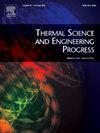有机朗肯循环选择工质的理论研究
IF 5.4
3区 工程技术
Q2 ENERGY & FUELS
引用次数: 0
摘要
本文建立了流体性质与循环性能之间的数学关系,建立了工作流体选择的准则。预测循环性能的理论模型结合了热力学原理和基于流体性质的几种热物理关联。为了获得最大的净功率输出,导出了最佳蒸发温度作为热源温度和流体性质函数的理论表达式。通过引入由工作温度、汽化潜热、饱和液体线斜率和膨胀蒸汽等压线斜率组成的特征参数χ,分析了流体性质与循环性能之间的关系。通过与前人研究结果的比较,验证了特征参数χ作为选择标准的有效性。结果表明,理论模型具有较高的精度,与数值模拟的最大相对偏差小于3%。无论是否存在出口温度约束,最佳蒸发温度的标准差保持在3 K以下,变异系数小于0.8%,说明流体性质对最佳蒸发温度没有显著影响。考虑到非等温冷凝过程,净功率输出与特征参数χ呈现一致的线性关系,在四种情况下Pearson相关系数保持为1。海上应用中orc工作流体选择的案例研究表明,特征参数χ是干燥和等熵工作流体的有效选择标准。本文章由计算机程序翻译,如有差异,请以英文原文为准。
Theoretical study of organic Rankine cycle for working fluid selection
This paper establishes a mathematical relationship between fluid properties and cycle performance to establish a criterion for working fluid selection. The theoretical model for predicting cycle performance incorporates thermodynamic principles and several thermophysical correlations based on fluid properties. To achieve maximum net power output, a theoretical expression for the optimal evaporation temperature is derived as a function of heat source temperature and fluid properties. The relationship between fluid properties and cycle performance is analyzed by introducing a new feature parameter χ, which consists of operating temperatures, latent heat of vaporization, the slope of the saturated liquid line, and the slope of the isobaric line of expanded vapor. The effectiveness of the feature parameter χ as a selection criterion is validated by comparison with results from previous studies. Results show that the theoretical model achieves high accuracy, with maximum relative deviations below 3 % compared to numerical simulations. Regardless of whether the outlet temperature constraint is present, the standard deviation of the optimal evaporation temperature remains below 3 K, with a coefficient of variation of less than 0.8 %, indicating that the fluid properties have no significant impact on the optimal evaporation temperature. By accounting for the non-isothermal condensation process, the net power output shows a consistent linear relationship with the feature parameter χ, with the Pearson correlation coefficient remaining 1 across four cases. Case studies of working fluid selection for ORCs in maritime applications indicate that the feature parameter χ serves as an effective selection criterion for dry and isentropic working fluids.
求助全文
通过发布文献求助,成功后即可免费获取论文全文。
去求助
来源期刊

Thermal Science and Engineering Progress
Chemical Engineering-Fluid Flow and Transfer Processes
CiteScore
7.20
自引率
10.40%
发文量
327
审稿时长
41 days
期刊介绍:
Thermal Science and Engineering Progress (TSEP) publishes original, high-quality research articles that span activities ranging from fundamental scientific research and discussion of the more controversial thermodynamic theories, to developments in thermal engineering that are in many instances examples of the way scientists and engineers are addressing the challenges facing a growing population – smart cities and global warming – maximising thermodynamic efficiencies and minimising all heat losses. It is intended that these will be of current relevance and interest to industry, academia and other practitioners. It is evident that many specialised journals in thermal and, to some extent, in fluid disciplines tend to focus on topics that can be classified as fundamental in nature, or are ‘applied’ and near-market. Thermal Science and Engineering Progress will bridge the gap between these two areas, allowing authors to make an easy choice, should they or a journal editor feel that their papers are ‘out of scope’ when considering other journals. The range of topics covered by Thermal Science and Engineering Progress addresses the rapid rate of development being made in thermal transfer processes as they affect traditional fields, and important growth in the topical research areas of aerospace, thermal biological and medical systems, electronics and nano-technologies, renewable energy systems, food production (including agriculture), and the need to minimise man-made thermal impacts on climate change. Review articles on appropriate topics for TSEP are encouraged, although until TSEP is fully established, these will be limited in number. Before submitting such articles, please contact one of the Editors, or a member of the Editorial Advisory Board with an outline of your proposal and your expertise in the area of your review.
 求助内容:
求助内容: 应助结果提醒方式:
应助结果提醒方式:


